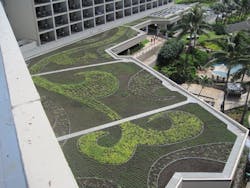Green Roofs Continue to Transform The Urban Landscape
Vegetative roofs, or green roofs, have been on the rise in commercial construction. In North America, Washington, D.C. is leading the way, with almost 1.6 million sf of green roof installed in 2015, according to Green Roofs for Healthy Cities (GRHC). Long popular in Europe, metropolitan areas on the American side of the Atlantic Ocean are catching on to the idea of creating “natural” environments on rooftops as a way to lower operating costs, lower impact on the environment, and enhance the livability of buildings. In fact, after falling 12% in 2014, green roof installation was up 18.5% overall in 2015, says the GRHC.
Currently, the green roof market is being driven by policy decisions at the municipal level that encourage or incentivize vegetated roofs. Some cities such as Los Angeles and Seattle have mandated green roofs on any new building over a certain size, or with a limited roof slope. Others have incentivized green roofs by offering attractive cost rebates, property tax rebates, or high sewer fees that can be reduced by installing a green roof.
Policy shifts toward basic levels of LEED certification, such as in Los Angeles, can also favor green roofs. With the potential to contribute as many as 15 LEED credits—either directly or in combination with other sustainable building elements—green roofing can result in the earning of credits such as:
- Reduced Site Disturbance
- Landscape and Exterior Design To Reduce Urban Heat Islands
- Stormwater Quantity Control
- Water Efficient Landscaping
- Innovative Wastewater Technologies.[1]
With the advent of LEED v4, which was first announced in 2013 and became open for registration in 2016, commercial roofing teams must now keep up with the latest in green roofing technologies in order to obtain credits. Registration for the previous edition, LEED 2009, ended October 31, 2016, and since then new projects registering for LEED must adhere to v4 standards, which are considered much more rigorous and the program’s largest overhaul in 18 years. In one change from LEED 2009, according to the U.S. Green Building Council, vegetated roofs have equal weight with high-reflectance roofs when calculating compliance.
Another force increasingly coming into play in green roofs is utility. Both owners and design professionals have begun to realize that, in addition to environmental benefits to air quality, water quality, and carbon reduction, a green roof, or any other vegetative space, is beneficial as a garden.
Hospitals are planting healing gardens both at ground level and on rooftops. Studies have shown that gardens and other contact with nature—even only visual contact from looking out a window—can lower the need for pain medication and shorten hospital stays. Children’s hospitals and cancer units have been especially keen on this therapeutic benefit, sometimes outfitting the facility rooftop with electrical outlets and emergency backup power so patients can visit the garden with their electrically-powered life-support devices. In a similar manner, office buildings are increasingly installing green roofs as a quality-of-life enhancement that contributes to better productivity and worker satisfaction.
Another growing approach to green roofs is to produce food. Turning the roof into a farm increases the resiliency of cities, growing high-value food very close to the people who are going to consume it. This idea is being embraced in community gardens and schools, where it provides educational value as well as fresh produce.
With more owners and developers looking to implement green roofing across their buildings, particularly in urban areas where green space may be hard to come by, the practice is certainly growing in more ways than one. Green roofs are projected to grow into a $7 billion market by 2017, according to Lux Research.[2] As environmental and regulatory incentives evolve, the adoption of green roofing construction will too.
References
1 http://www.usgbc.org/credits/
2 http://www.businesswire.com/news/home/20121018005232/en/Burgeoning-Green-Roofs-Green-Walls-Market-Worth
